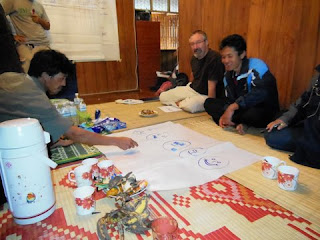Aquaponic setups are generally closed systems, by which
water and nutrients are recycled between the aquatic animals and crops,
with water added only as needed. However, other inputs are required,
such as feed for the fish, as well as certain micro-nutrients (e.g.
iron) that are often needed to keep the crops adequately nourished and
to keep the pH of the water in balance. Microorganisms are also
required by the system so that the ammonium produced by the fish can be
reduced to a form of nitrogen that the plant roots can readily absorb
(i.e. nitrate). This means that oxygen, pH, iron, ammonia, nitrite and
nitrate levels need to be at acceptable levels to make the entire system
non-toxic and productive.
Considering all, aquaponics systems are quite complicated
and aren't as easy to set up and maintain as basic container gardens.
Not just anyone can install such a elaborate system and/or operate it
so that vegetables and fish are continually in production. Therefore, a
certain degree of expertise and planning as well as the capacity to
carry out long term management are required. The cost of installing
such systems can also be expensive. However, aquaponics systems are
quite appealing to many, and can be feasible, especially where
production areas for vegetables are limited (as well as access to fresh
water), and the demand for aquaponics products is high.
The key product of most aquaponic systems is
vegetables. So in places where most vegetables are plentiful and cheap,
aquaponic systems may have trouble paying for themselves.
With the assistance of our own aquaponics guru,
Scott Breaden, we have been slowly setting up a small demo aquaponics system at
the ECHO Asia office in Chiang Mai. After months of gradual
installation of components, our system is still not even close to full
production capacity. But we are learning lots of valuable lessons in
the process.
However, I recently came across a very impressive
and productive aquaponics system at Aloha House, an orphanage with a
farm in Palawan, Philippines. There are actually two major aquaponics
systems at Aloha House. A large, outdoor system has been set up on a
sloping plot of land that is made up of several long, cement, watertight
crop-production tanks through which the water flows by gravity from the
top tank to the bottom fish tanks before being clarified and pumped
back up to the top. In addition to tilapia, this system currently
produces tomatoes, salvinia (Salvinia molesta - an invasive
aquatic fern used at Aloha House to feed livestock and fish), rice and
various vegetables such as watercress. Ducks are also incorporated,
having regulated access to certain parts of the system so that they can
feed on salvinia and snails and be happy.
A second roof-top system at Aloha House enables the
level of the water pumped up from the tilapia tanks to rise and fall in a
series of shallow, plastic-lined trays, allowing leafy vegetable crops
(such as lettuce) planted in cups and situated in the trays to remain
adequately watered, aerated and supplied with nutrients. Strategically
placed biological filters that use rocks, soil and plants (such as
nasturtium), as well as synthetic filters, help to reduce sediments and
keep the water flowing. Water used for both systems at Aloha House is
approximately 75 percent rainfed, with rain water efficiently harvested
from roofs for use in the aquaponics system.
Keith Mikkelson, founder of Aloha House, stresses
that his system took years of trial and error and considerable capital
before becoming productive enough to produce both food and income for
the orphanage. Although he has a lot of interested visitors, considering the
cost, expertise, time and management required to make aquaponic systems
practical, Keith admittedly talks most interested parties out of setting
up their own.
For more information about the Aloha House aquaponics systems, contact Keith Mikkelson at mik@mozcom.com.

































